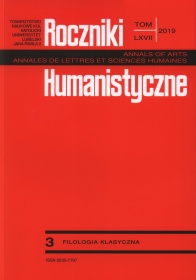Materia nasienia a dziedziczenie cech jednostkowych w De generatione animalium Arystotelesa
Abstrakt
Choć zgodnie z teorią reprodukcji, przedstawioną przez Arystotelesa w traktacie De generatione animalium, zadaniem samca w procesie rozrodu jest zawsze przekazywanie formy, natomiast samica dostarcza materii, w przypadku zwierząt krwistych również samce spełniają swoją funkcję za pomocą materialnego narzędzia, zwanego nasieniem bądź płynem nasiennym. Arystoteles opisuje go jako rodzaj piany, złożonej z wody, ziemi i pneumy, która, będąc nośnikiem ciepła życiowego, czyni nasienie płodnym. Ponieważ płyn nasienny wytwarzany jest z krwi – ostatniej formy pożywienia, przeznaczonej to tego, aby stać się budulcem dla wszystkich części organizmu zwierzęcia, którego serce ją wytwarza – jest on wyposażony w ten sam ruch (lub raczej zestaw ruchów), za pomocą którego rośnie ciało danego zwierzęcia. W procesie reprodukcji ruchy te nie tylko więc przekazują potomstwu samą zasadę ruchu i formę gatunkową, lecz również dążą do odtworzenia w ciele potomka indywidualnych cech ojca. Z tej właśnie przyczyny samce, które nie wytwarzają nasienia, nie są w stanie spłodzić potomstwa podobnego do siebie.
W artykule staram się również wykazać, że przekazywanie cech jednostkowych zależy nie tylko od zawartej w nasieniu pneumy, lecz również „ziemistego elementu” tworzącego jej otoczkę, ponieważ, poprzez zachowywanie i intensyfikowanie życiowego ciepła, przyczynia się on do zwiększenia efektywności wspomnianych ruchów.
Bibliografia
Aristotelis Opera ex recognitione Immanuelis Bekkeri, editio altera quam curavit O. Gigon, Berolini 1960.
Aristotle, Generation of Animals with an English translation by A.L. Peck, The Loeb Classical Library 1953.
Arystoteles, Dzieła wszystkie, t. I-VI, Warszawa PWN 1990-2001.
Balme D.M.: Aristotle’s biology was not essentialist, w: Philosophical Issues in Aristotle’s Biology, red. A. Gotthelf, J.G. Lennox, Cambridge: Cambridge University Press 1987, s. 291-312.
Bos A.P., Aristotle on God’s Life-Generating Power and on Pneuma as Its Vehicle, Albany: SUNY Press 2018.
Connell S.M.: Aristotle on Female Animals. A study of the “Generation of Animals”, Cambridge: Cambridge University Press 2016.
Cook K.C., Sexual Inequality in Aristotle’s Theories of Reproduction and Inheritance, w: Feminism and Ancient Philosophy, red. J.K. Ward, New York–London 1996, s. 51-67.
Cooper J.M., Metaphysics in Aristotle’s Embryology, „Proceedings of the Cambridge Philological Society” 34(1988), s. 14-41.
De Ribera-Martin I., Seed (Sperma) and Kuêma in Aristotle’s Generation of Animals, „Journal of the History of Biology” 2018, s. 1-38.
Eichman P., Sex, Blood and Soul: The Transmission of Form in Aristotle’s Biology, https://echodin.net/papers/phil515/aristotle.pdf, 2007.
Freudenthal G., Aristotle’s Theory of Material Substance: Heat and Pneuma, Form and Soul, Oxford: Clarendon Press 1995.
Gelber J., Form and Inheritance in Aristotle’s Embryology, „Oxford Studies in Ancient Philosophy” 39(2010), s. 183-212.
Gelber J., Causes and Kinds in Aristotle’s Embryology. A dissertation for the DPh degree, Berkeley: University of California 2010.
Gelber J., Females in Aristotle’s Embryology, w: Aristotle’s Generation of Animals. A Critical Guide, red. A. Falcon, D. Lefebvre, Cambridge: Cambridge University Press 2018, s. 171-187.
Henry D., Aristotle on the Mechanism of Inheritance, „Journal of the History of Biology” 39(2006), nr 3, s. 425-455.
Henry D., Embryological Models in Ancient Philosophy, „Phronesis” 50(2005), nr 1, s. 27-40.
Henry D., How Sexist is Aristotle’s Developmental Biology?, „Phronesis” 52(2007), nr 3, s. 251-269.
Henry D., Understanding Aristotle’s Reproductive Hylomorphism, „Apeiron” 39(2006), nr 3, s. 257-288.
Littlehailes L., Vital Heat, Conception and Development in Aristotle. Thesis submitted for the degree of D.Phil, Oxford: Jesus College 1990.
Lones T.E., Aristotle’s Researches in Natural Science, London 1912.
Sowa J., Czy kobieta jest potworem? Płeć żeńska w „De generatione animalium” Arystotelesa, „Roczniki Humanistyczne” 62(2014), z. 3, s. 27-48.
Sowa J., Dlaczego potrzebne, skoro niepotrzebne? O materialnym kształcie przyczyny sprawczej w „De generatione animalium Arystotelesa, „Archiwum Historii Filozofii i Myśli Społecznej” 63(2018), s. 283-298.
Sowa J., O tajemniczych „ruchach” w „De generatione animalium” IV, 3. Płeć żeńska w Arystotelesowskiej teorii dziedziczenia, „Roczniki Humanistyczne” 64(2016), z. 3, s. 31-52.
Sowa J., When does a man beget a monster, „Collectanea Philologica” 19(2016), s. 5-13.
Trompoukis C., Kalaitzis C., Giannakopoulos S., Sofikitis N., Touloupidis S., Semen and the diagnosis of infertility in Aristotle, „Andrologia” 39(2007), nr 1, s. 33-37.
Upton T.V.: Aristotle on Monsters and Generation of Kinds, „American Catholic Philosophical Quarterly” 77(2003), nr 1, s. 21-36.
Witt Ch.: Form, Reproduction, and Inherited Characteristics in Aristotle’s „Generation of Animals”, „Phronesis” 30(1985), nr 1, s. 46-57.
Zwier K.R.: Metodology in Aristotle’s Theory of Spontaneous Generation, „Journal of the History of Biology” 51(2018), issue 2, s. 361-367.
Copyright (c) 2019 Roczniki Humanistyczne

Utwór dostępny jest na licencji Creative Commons Uznanie autorstwa – Użycie niekomercyjne – Bez utworów zależnych 4.0 Międzynarodowe.





